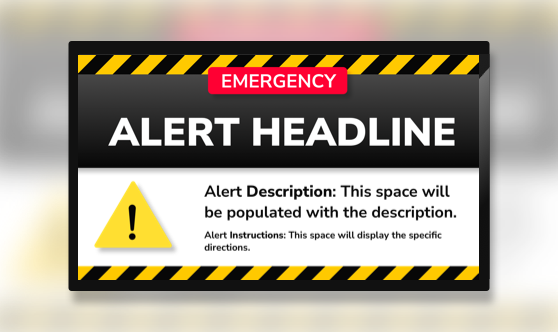
What is a Digital Signage Content Management System?
The screens that show your attractive and engaging content make up only a small portion of your digital signage system. Digital signage systems are designed with specific features and functionalities to meet business needs. There are various other hardware and software that power up your display and help you deploy an effective network that will bring you closer to your goals.
These may include digital media players, digital signage software, and of course, a content management system. The purpose of a digital signage CMS is to align display content with your business objectives, ensuring the right messages reach the right audience. The latter is the bread and butter of your content strategy, as the CMS manages, organizes, and schedules content, helping you create and publish content that will show up on your screens for your intended audience to see.
Nothing is more important than having a versatile and powerful content management system for your digital signage network. Centralized management allows you to control content across multiple screens and locations efficiently. In this article, we’ll walk you through digital signage content management systems and the features you should look for to find the best solution for your business.
What is Digital Signage Content Management System?
Digital signage content management system (CMS) is software that allows you to display digital media on your screens from any server. It comes with a range of applications and features that can support various media types, whether text, images, videos, animations, or live streams. Different locations or audiences may require specific content or language support, and a CMS enables you to manage these requirements efficiently.
Digital signage CMS will also have features that facilitate content creation, editing, scheduling, and overall screen management.
Think of it as the lifeblood of your digital signage network — no content can be displayed on your screens without it. Unlike limited solutions that only allow content display via USB drives, a full-featured CMS offers robust capabilities for remote and automated content management.
Features of Digital Signage CMS
Let’s review the features that you’ll typically find in digital signage CMS. Effective CMS features depend on the compatibility and management of various hardware devices, such as screens, media players, and other peripherals. Adding new devices or media players to the system is usually straightforward, allowing for easy integration and expansion.
Content Creation, Editing, and Publishing
The most basic function of digital signage CMS is to allow you to upload files from your computer or cloud storage and deploy content onto your screens. You’ll find this primary feature right on the CMS dashboard for easy access whenever you need it. Uploading and displaying basic content, such as text or images, is a simple process that can be managed by users of any skill level. Tablets can also be used as portable digital signage displays, making it easy to manage and present content in various locations.
Some CMS will come with more advanced content management features like content design applications and compositions and playlists.
Content Design Applications

In addition to content publishing, there are digital signage CMS in the market that allows users to create their content directly from the software. They do this by integrating online design apps, stock image websites, and free templates. Some CMS platforms also support touch-enabled content creation, allowing users to design interactive digital signage experiences that engage audiences through touchscreen displays.
Compositions and Playlists
Digital signage CMS may also boast features for designing and editing content layouts. Compositions and playlists help you customize your display and maximize the use of screen space.
With these features, you can dictate where widgets specifically show up on your screens, the sequence in which your content will play, and how long each media will be visible in the display before moving on to the next one.
Real-Time Content Display
One of the main benefits of digital signage over traditional signage is its ability to display fresh, updated content in real-time. This is possible through advanced digital signage CMS features that allow you to upload and deploy content remotely and change your display anytime you need to.
Some CMS may also support live content broadcasting, which you can take advantage of to display weather reports, real-time weather updates, RSS feeds, and other live streams. This ensures that your screens display auto-refreshing content that prevents them from going stale.
Content Scheduling
Digital signage CMS doesn’t only allow you to publish content instantly. It also gives you the option to schedule content for later, ensuring you never miss a deadline or opportunity to keep your screens up-to-date. This feature comes in handy for upcoming events, product launches, or seasonal discounts you need to promote. Additionally, you can schedule content for specific times of the day, such as breakfast promotions in the morning or special offers during evening hours, to better target your audience and maximize campaign effectiveness.
With content scheduling capabilities within your CMS, you don’t have to keep track of dates and manually upload files to your software frequently. You just have to line them up in your CMS to auto-play at your designated date and time. Outdoor digital signage is designed to operate effectively for many days without maintenance, ensuring your scheduled content displays reliably and consistently.
Emergency Alert Features

With its wide reach and dynamic display that catches the viewer’s attention, digital signage is a very powerful tool to broadcast emergency alerts. While only offered by advanced CMS, a feature that allows you to override existing content to display ad-lib emergency notifications may be quite useful.
This feature makes it easy for you to inform your viewers of emergency situations and provide them with instructions concerning evacuation protocols or safety measures. And in the event of an emergency where time is of the essence, emergency alerts in your digital sign can initiate your viewer’s response to secure their safety.
Screen Network Management
Digital signage CMS doubles as a screen management system where you can track and monitor all your screens and deploy the right content in each location.
For example, advanced CMS may have screen grouping features that categorize your screens and publish different variations of content for each screen group, eliminating the tedious job of manually changing content for every display in your muti-screen digital signage network.
Types of CMS for Digital Signage
Digital signage CMS comes in two types:
- A system that you can access and operate remotely on the cloud
- One that functions on a physical IT infrastructure
Cloud-Based Digital Signage CMS

Cloud-based digital signage CMS operates on a cloud, allowing access to it from any geographical location. It works similarly to opening an email, which you can do from any device with an Internet connection.
Cloud-based CMS is suitable for remote access and management of your digital signage network. You only have to register or avail of a subscription with the platform and log in using your user ID and password anytime you need to access your dashboard. Additionally, cloud-based CMS can integrate with other business systems, such as social media feeds or inventory management platforms, to enhance functionality and enable real-time data display.
Because the platform does not operate in a physical location, cloud-based CMS allows you to scale your digital signage network without worrying about complex IT infrastructure. It can also keep your data secure, with everything backed up on the cloud.
Most cloud-based CMS providers offer their services on a pay-as-you-go pricing model, so you can customize your subscription based on your needs.
On-Premise Digital Signage CMS

In comparison, on-premise digital signage CMS operates in a physical location and requires an IT setup to use and access. It uses software installed on a private network instead of a cloud, so it cannot be accessed remotely.
Because of these limitations, on-premise CMS is best reserved for large companies that have big, reliable IT ecosystems they can utilize to manage their digital signage network. With a strong IT infrastructure, though, on-premise CMS can be more powerful than cloud-based CMS, providing the user with more authority, exclusivity, and customization.
Hybrid Digital Signage
You know, hybrid digital signage is honestly changing the game when it comes to how businesses talk to their customers. It's kind of like getting the best of both worlds—you've got your traditional signage that people are used to, but then you mix in those dynamic digital displays that can actually do something interesting. This combo lets companies create displays that really grab your attention, right? They're not just showing off products and services anymore; they're flashing those real-time promotional deals that make you stop and think, "Hey, that's actually worth checking out." When you're walking through retail stores or shopping malls these days, these up-to-date visuals and info really do make the whole experience feel smoother and more engaging.
Here's the thing about hybrid digital signage—businesses can switch up their messaging whenever they want. Need to highlight the latest promotions? Done. Got an upcoming event to announce? Easy. Services changing? No problem. It's honestly pretty convenient because shoppers like you always get the most relevant stuff instead of staring at outdated posters from last month. This approach really helps with visual communication and makes retailers stand out when you're walking through those busy, high-traffic areas. Whether they're trying to inform you about something, promote a deal, or just entertain you while you shop, hybrid digital signage gives them this versatile way to connect with all kinds of people and deliver that real-time info exactly where and when it matters most.
Things to Look for in Digital Signage CMS
Not all CMS are built the same. Some have more features that can help you optimize and scale your content, while others are able to support only certain digital signage hardware. CMS should also be compatible with advanced display technologies such as LED displays, which are known for their energy efficiency and cost-effectiveness. Digital signage is commonly used in locations like a shopping mall, where engaging visitors and providing real-time information is essential. Integration with social media feeds is a valuable feature for keeping content dynamic and engaging.
To help you make the right decision about the digital signage CMS you choose, here are some things to look for:
Hardware Compatibility
Not all CMS have a universal application that can support a wide range of digital signage hardware. If you don’t take hardware compatibility into consideration, you run to risk of your CMS not working with your chosen operating systems.
You should look for CMS that is hardware neutral or at least able to support popular digital signage media players like Chrome OS, Android, macOS, Windows, and Linux.
Screen Compatibility
Your CMS should also be compatible with your chosen digital signage screen, whether that be a large video wall, an interactive kiosk, or a TV monitor repurposed into a digital sign. While most digital signage CMS can work with any display or screen type, make sure to identify what kinds of solutions they offer and determine if they suit your business’s needs.
Security Features
Like any digital solution, digital signage CMS can also be prone to data loss and other security risks. You want to make sure that your CMS has robust security features in place that protect your data during transfer, storage, and display. Some things to look out for include:
- Data and hardware encryption
- Safe IP address designation
- Alignment with your corporate security policy
- Fast tech support
User Control Customization
You likely won’t have only one person managing your digital signage CMS. More often than not, multiple people will be tasked with uploading, scheduling, and optimizing content to show up on your screens.
If that’s the case, you need CMS that allows you to add and remove users or customize their roles and access within the system.
User-friendly Interface
Many businesses are hesitant about investing in digital signage solutions because they think that they need a full-blown IT team to manage their network and deploy their content. But that’s not the case, as long as you focus on looking for software with a user-friendly interface that anyone can use and navigate.
Some user-friendly features to look out for include:
- Flexible screen layouts - allow you to maximize screen space and customize where media will show up in the display.
- Multi-user login - allows more than one user to access the CMS from different devices.
- Organized view - has a neat and well-organized dashboard that’s not cluttered with buttons. The features should be easy to navigate and execute for a non-technical end user.
- User role modulation - allows the administrator to give access permissions to secondary users.
A good rule of thumb is your digital signage CMS should be intuitive and easy to use — even for someone with minimal training.
Regular Software Updates
There’s no such thing as a perfect digital signage CMS. They all need regular updates to fix bugs and improve their features and characteristics. Software updates should be standard in a digital signage CMS service and should take place regularly with no extra charge to the user.
You might also want to ask your vendor about how software updates are conducted. As much as possible, look for a provider who can run updates and fixes remotely to save you time and resources.
Rise Vision Hardware Options
Hardware matters. You can have great software, but if your media player keeps failing... well, you've got a problem.
The Rise Vision Media Player handles the basics well. Compact design, cloud-managed, covers everything from standard digital signage to emergency alerts. Quick setup process. Currently available in the US and Canada, which means you're getting hardware that's actually supported in your region.
Then there's the Avocor displays. These are all-in-one units, so you don't need a separate media player. The 4K visuals look sharp, and the integration with Rise Vision's software means you're managing everything from one dashboard. Screen sharing works seamlessly, emergency alerts display instantly. It's the kind of setup that just... works.
Both options come with flexible purchasing arrangements through their Hardware as a Service program.
Rise Vision Compared to Other CMS Providers
You're probably wondering how different platforms stack up. Here's what separates Rise Vision from many other digital signage CMS solutions:

The main difference? Rise Vision focuses on removing the usual barriers—no proprietary hardware lock-in, no surprise fees, no limits on team access. You get what you need without the complications that tend to show up with other solutions.
Measuring Success with Digital Signage
You know, figuring out how well your digital signage campaigns are actually working is honestly pretty crucial if you want to get the most bang for your buck and hit those business goals you've set. By digging into analytics and data—and trust me, there's a lot you can learn from it—you can track key stuff like how long people actually stick around looking at your screens, how engaged they really get, and whether they're converting into actual sales across your whole digital signage setup. These insights are kind of like having a behind-the-scenes look at how your content's performing, and they help you spot where there's room to make your messaging and overall strategy way better.
Here's the thing: tracking the right metrics lets you make smart, informed calls about what content to put on your digital signage displays, so each campaign actually delivers what you're hoping for. When you're constantly analyzing that data—and I mean really staying on top of it—you can fine-tune your approach, optimize how your digital signage network runs, and honestly drive way more engagement and sales than you might expect. At the end of the day, measuring success with digital signage gives you the power to create campaigns that pack more punch and get you a much better return on what you've invested. It's pretty amazing what those numbers can tell you if you know where to look.
Analytics and ROI
You know, analytics really are a game-changer when it comes to making your digital signage content actually work. Think about it—by gathering and digging into data on how viewers engage, which content performs best, and whether your screens are even staying up and running, you get these valuable insights into what actually clicks with your audience. It's kind of like having a behind-the-scenes look at what grabs attention and what... well, doesn't. This info lets you fine-tune your scheduling, tweak those playlists, and honestly, deliver content that doesn't just sit there but actually captures attention and gets people to do something.
ROI analysis is just as crucial, right? It helps you figure out the real financial impact of putting money into digital signage in the first place. When you evaluate how your campaigns actually performed, you can see which strategies work best and put your resources where they'll do the most good. Using analytics and ROI metrics like this, you can keep improving your digital signage campaigns, boost engagement, and honestly, maximize the impact your content has across your whole network. It's not just about throwing content up there and hoping for the best—it's about making smart moves based on what the data's telling you.
Digital Signage Industry Trends
You know, the digital signage world is changing pretty fast these days, and honestly, it's kind of exciting to see where things are heading. One of the biggest shifts you're probably noticing is how businesses are jumping on cloud-based digital signage solutions—and for good reason. Think of it like having your entire signage network in your pocket instead of being tied down to clunky on-site servers. These cloud platforms are really game-changers because they give you that flexibility and scalability that just makes sense. Whether you're managing one screen or hundreds across different locations, you can update content, keep an eye on how things are performing, and coordinate everything from one central dashboard. It's kind of like being the conductor of an orchestra, but instead of musicians, you're directing all your displays to work in perfect harmony.
Here's where things get really interesting though—businesses aren't just looking for flashy screens anymore. They want their digital signage to actually talk to their other systems and work together like a well-oiled machine. As this whole industry keeps pushing forward, companies are hunting for solutions that streamline their operations, make content delivery smoother, and give them those real-time insights that help them understand how their campaigns are actually performing. If you're running a business and want to stay ahead of the game, keeping up with these trends isn't just nice to have—it's honestly essential for getting the most bang for your buck from your digital signage investments.
Emerging Technologies and Innovations
You know, emerging technologies are really shaking things up in the digital signage world, and honestly, it's pretty exciting stuff. Tools like Bluetooth, beacons, and mobile sensors—they're giving businesses ways to connect with customers that feel fresh and, well, kind of smart. Think about it: you're walking through a store, and boom, your phone gets a specific deal just because you wandered into the electronics section. That's Bluetooth beacons doing their thing. Or picture this—you're in a shopping mall, and the digital signs are actually adjusting what they show based on how many people are around. It's like the screens are paying attention to the crowd and responding in real time. Pretty cool, right?
Here's the thing though—these aren't just flashy tech tricks. They actually make shopping better for you and more profitable for businesses. When you get offers that feel relevant instead of random, you're way more likely to engage with them, and honestly, that just makes sense. By weaving these technologies into their digital signage setups, businesses can create experiences that feel interactive and... well, memorable. As this whole industry keeps evolving (and it's moving fast), staying on top of these trends isn't just nice to have—it's pretty much essential if you want your digital signage to actually work and deliver results that stick around.
What Customers Are Saying
Real feedback from people actually using Rise Vision:
Chet Neal notes: "Highly recommend! The school uses it extensively to convey school events and positive messaging to students. Content management is intuitive, and Rise Vision's continuous development of templates keeps content fresh and engaging."
Jeremy Bolden shares: "Rise Vision has transformed our campus communication. The media players are reliable, and the templates and remote management tools make promoting events effortless."
Jonathan Schilling adds: "Rise Vision offers superior features and an intuitive management console. Their customer support is excellent, and the pricing is competitive."
Choose the Best CMS for Your Digital Signage
The right digital signage CMS will allow you to maximize your displays, easily deploying and updating content to advance your business’s marketing and communications goals. Take the time to weigh your options and look for a digital signage CMS vendor that meets your needs and provides value for your business.
Start optimizing your digital signage with Rise Vision. Book a free demo with us to learn more about our free signage software.
More From Our Blog
-

Screen Sharing for Workplace Collaboration | Rise Vision
Screen-sharing technology has transformed how teams communicate and work together in real-time, regardless of their location. It can make presentations more engaging, support remote work, and speed[…]
Read More -

How to Use PowerPoint for Digital Signage
To create stunning, attention-grabbing, and effective digital signage content, you need the help of content creation and presentation tools. One of the most popular is Microsoft PowerPoint, owing to[…]
Read More -

120 Digital Signage Content Ideas
So…. you decided you would invest in some digital signage software and you need some ideas for ways you can make it stand out. This article is your go-to source for the best digital signage content[…]
Read More
Keep Your Displays Interesting – Pick New Templates Every Week!
Every week, we send template recommendations that will make you look great and improve your audience experience. And the best part, they save up to 16 hours of content creation time every week!
12,300+ Organizations Trust Rise Vision, You Can Too
Schedule a Free Demo
You deserve the #1 all-in-one platform for digital signage, screen sharing, and emergency alerts.



































